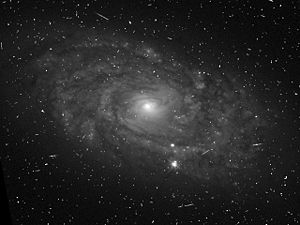NGC 513
| Galaxy NGC 513 |
|
|---|---|

|
|
| Photo from the Hubble Space Telescope | |
| AladinLite | |
| Constellation | Andromeda |
|
Position equinox : J2000.0 , epoch : J2000.0 |
|
| Right ascension | 01 h 24 m 26.8 s |
| declination | + 33 ° 47 ′ 58 ″ |
| Appearance | |
| Morphological type | Sb / c / Sy2 |
| Brightness (visual) | 12.9 mag |
| Brightness (B-band) | 13.6 mag |
| Angular expansion | 0.7 ′ × 0.3 ′ |
| Position angle | 70 ° |
| Surface brightness | 12.1 mag / arcmin² |
| Physical data | |
| Affiliation | WBL 40 |
| Redshift | 0.019544 ± 0.000033 |
| Radial velocity | 5859 ± 10 km / s |
|
Stroke distance v rad / H 0 |
(268 ± 19) · 10 6 ly (82.3 ± 5.8) Mpc |
| history | |
| discovery | Wilhelm Herschel |
| Discovery date | September 13, 1784 |
| Catalog names | |
| NGC 513 • PGC 5174 • CGCG 521-020 • MCG + 06-04-016 • IRAS 01216 + 3332 • 2MASX J01242680 + 3347585 • GC 297 • H III-169 • h 111 • GALEX J012426.69 + 334757.2 • LDCE 74 NED077 | |
NGC 513 is a spiral galaxy with an active nucleus of the Hubble-type Sc in the constellation Andromeda in the northern sky . It is estimated to be 268 million light years from the Milky Way and about 70,000 light years in diameter.
The galaxies NGC 512 , NGC 515 , NGC 523 , NGC 528 are located in the same area of the sky .
The object was discovered on September 13, 1784 by the German-British astronomer Friedrich Wilhelm Herschel .
Web links
Commons : NGC 513 - collection of images, videos, and audio files
